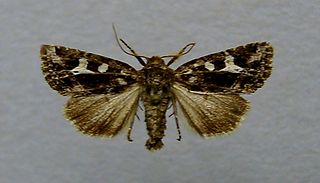
The green hairstreak is a small butterfly in the family Lycaenidae.

The pearl-bordered fritillary is a butterfly of the family Nymphalidae found in Europe and through Russia across the Palearctic to the north of Kazakhstan.

The dark green fritillary is a species of butterfly in the family Nymphalidae. The insect has a wide range in the Palearctic realm - Europe, Morocco, Iran, Siberia, Central Asia, China, Korea, and Japan.

The scarce large blue is a species of butterfly in the family Lycaenidae. It is found in Austria, Slovenia, Croatia, the Czech Republic, France, Georgia, Germany, Hungary, Italy, Japan, Kazakhstan, Mongolia, Poland, Romania, Russia, northern Serbia, Spain, Switzerland, and Ukraine and East across the Palearctic to Japan. The species was first described by Johann Andreas Benignus Bergsträsser in 1779.

Scolitantides orion, the chequered blue, is a species of butterfly in the family Lycaenidae. It is found in Europe, Russia and east across the Palearctic to Japan.

Coenonympha hero, the scarce heath, is a butterfly species belonging to the family Nymphalidae.

Autographa pulchrina is a moth of the family Noctuoidea. It is found in Europe East to the Urals and the Caucasus.Also in the Khentii Mountains (Mongolia) and East Siberia.

Boloria titania, the Titania's fritillary or purple bog fritillary, is a butterfly of the subfamily Heliconiinae of the family Nymphalidae.

Aricia nicias, the silvery argus, is a butterfly of the family Lycaenidae. It is found in the Alps, Pyrenees and from Scandinavia ranging to Siberia and the north of Mongolia.

Agriades optilete, the cranberry blue, is a butterfly of the family Lycaenidae. It is found in north eastern Europe, the Alps, North Asia, Japan, Korea and north western North America.

Muschampia tessellum, the tessellated skipper, is a butterfly of the family Hesperiidae. It is found from the southern Balkan Peninsula through Ukraine, southern Russia and Asia Minor, southern Siberia, Mongolia, east to the Amur region.

Celaena haworthii, or Haworth's minor, is a moth of the family Noctuidae. The species was first described by John Curtis in 1829. It is found from the British Isles and France through northern Europe including Scandinavia, east to the Urals and across the Palearctic to Siberia and up to the Pacific Ocean.

Erebia cyclopius is a species of butterfly of the subfamily Satyrinae in the family Nymphalidae. It is found through Siberia, northern Mongolia, northern China and North Korea. The habitat consists of forest edges, flowery meadows and sparse larch forests.

Lopinga deidamia is a species of butterfly in the family Nymphalidae. It is found from the Urals to southern Siberia, China, Mongolia, Korea and Japan.

Tongeia fischeri, or Fischer's blue, is a butterfly of the family Lycaenidae. It was described by Eduard Friedrich Eversmann in 1843. It is found in south-eastern Europe, the southern Ural, northern and eastern Kazakhstan, south-western and southern Siberia, the Russian Far East, Mongolia, China, Korea and Japan.

Euphydryas intermedia synonym ichnea is a small butterfly found in the Palearctic that belongs to the browns family. It occurs up to 2200 m above sea level.

Boloria angarensis is a small butterfly found in the Palearctic that belongs to the browns family.

Boloria oscarus is a small butterfly found in the East Palearctic that belongs to the browns family.

Erebia edda is a small butterfly found in the East Palearctic that belongs to the browns family.

Polyommatus damone is a Palearctic butterfly in the Lycaenidae family.




















